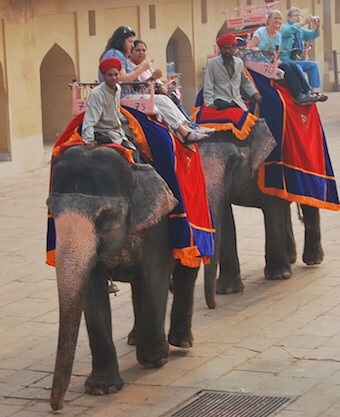
Dining For Women’s “Trunk Show”
By Donna Shaver
The Amber Fort in Rajhastan is yet another architectural marvel. We were all stunned by its beauty, design, and engineering — the result of almost unlimited resources. It was constructed by the Hindu Kachhawaha, who were allied with the powerful Muslim Mughal Empire. It was built in 1592 by Maharaja Man Singh I on the remains of an 11th century fort.
As we drove down the road, this huge complex arose on our left in the middle distance. From the road, you see across a green plain a long walled roadway slanting ever upwards toward the imposing ramparts of the Amber Fort. Looking closely you could see a long line of elephants making their way to the entrance to the fort, each carrying a mahawouat–the “driver”– and two tourists facing out over the plain. From this vantage point, you can see yet another fort higher on the hill following the ridge line. We were to learn that the two were connect by secret tunnels in case of attack.
We joined the long line, which moved with surprising speed. The next thing you know, you were standing on a platform in the “boarding area”–just the right height to to board the elephant. There is a platform on the elephant’s back, and the two of you sit facing out, feet on a footboard, and an iron bar across you as a handhold and safety precaution. The elephant moves off so the next in line can take on passengers.
It takes a few moments to get accustomed to the slow, but substantial sideways rocking motion. The elephants walk closely together, trunk to tail. Each mahawouat decorates his own elephant, so many have painted flowers and flourishes on their trunks and side, or bangles. Unlike African elephants, there is more natural color variation with the Asian elephants. Many have large, diffuse pink areas on their heads and trunks, sometimes with naturally occurring gray or black spots.
All along the way, there are photographers, blasting away with the hope of selling prints to the elephant riders. We were all taken with the hyperkinetic Tony #1. He fired away, following us over the incredibly uneven ground of the slope that rose in front of us, all the time shouting that he was “Tony #1, not Tony #2!” He assured us he was the best. (After our visit, we were set upon by many Sother photographers showing us the pictures they had taken of us. We said “No! Tony #2”. One kept insisting he was Tony’s son, but we weren’t buying. Indeed we did meet up with Tony #1 in the parking lot and bought our pics. We were quite happy with the results.)
The fort itself is astonishing, both in size and beauty. It contains many palaces and gardens, and is much larger than one might think. The stone pillars, arches, and screens were breathtaking, as was the view of the valley below.
The Maharajah had 12 wives, each with her own palace within the fort. They were both Muslim and Hindi, and each woman was allowed to worship in her own religion. The queens’ palaces were arranged so that the queens had a huge and elegant courtyard in which they would spend time with each other. Wisely, the Maharajah did not allow the queens to visit in each other’s palaces, so there was no jealousy or comparison. In addition, there was a elaborate series of stairs so the Maharajah could visit one of the queens and none of the others could see where he had gone. We agreed that the Maharajah was a wise man indeed.
Unfortunately, we had no elephantine assistance on the descent!
